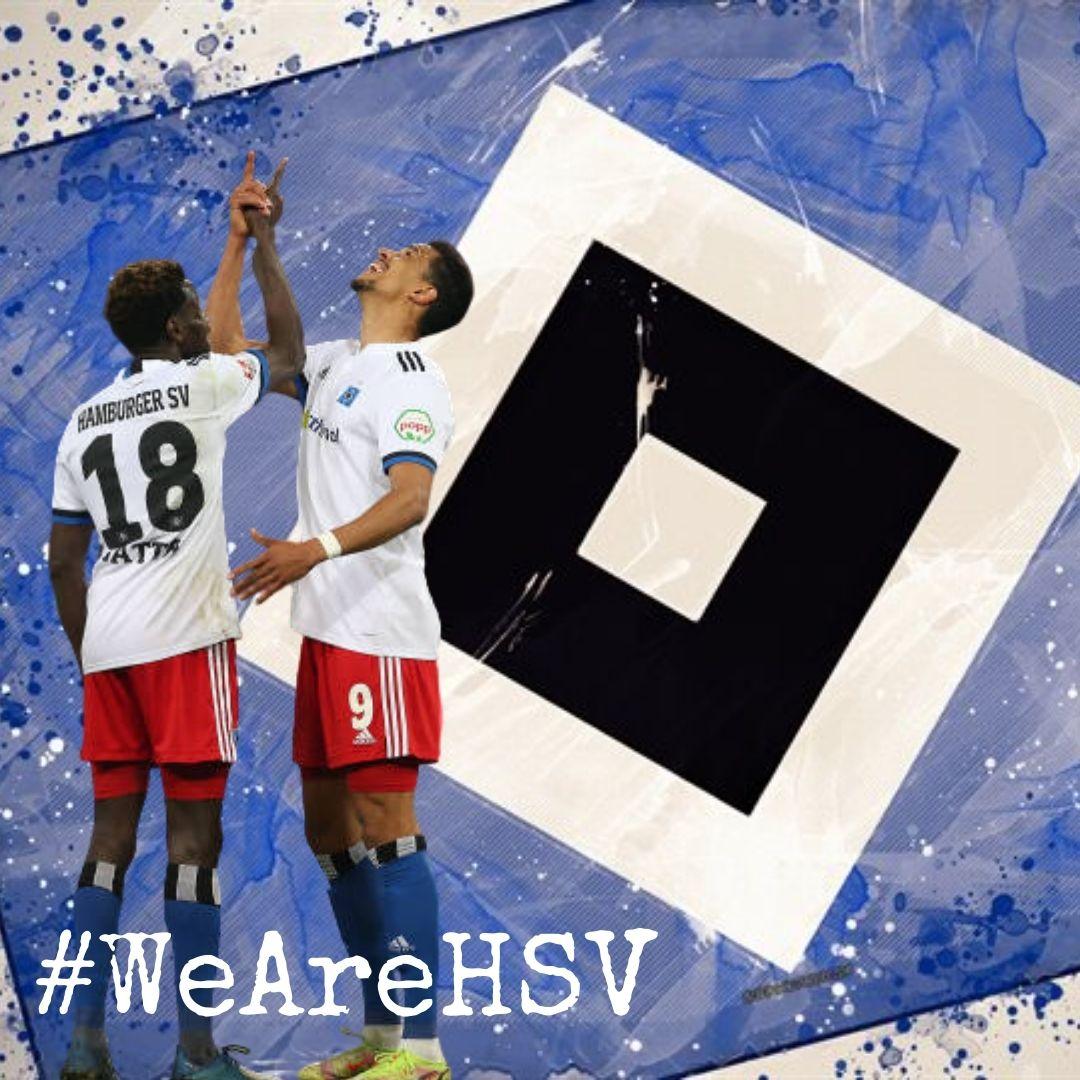
Implementing a wage structure & transfer policy in Football Manager
Assessing the situation
A wage structure is a great way to start getting a tough financial situation in order. When I first took over HSV I was aware their financial situation wasn’t great. So, when I clicked on the finances screen it wasn’t too much of a shock to read about the £42 million debt.

It’s a big debt and it’s being paid back at £875k per week. However, it’s not one I’m panicking about just yet. We have one thing in our favour – potential promotion to the Bundesliga.
Obviously, I’ve got to get the team there yet, but once there, the extra revenue should help alleviate some of the debt. A trip in to European football would be huge for the club… but let’s proceed one step at a time.
The board are expecting automatic promotion, so if I don’t manage that I at least want the finances to be in order to give me a small chance of keeping my job!
There are, of course, many ways in which to go about getting a club out of a bad financial situation, but I’ll explore those options when this season has finished.
With promotion to the Bundesliga the main goal, there’s a couple of things I can do to right away to start getting our house in order.
IMPLEMENTING A WAGE STRUCTURE
A wage structure is something I like to do in every Football Manager career, and I’ve touch on it previously with my Girona save. It adds a nice hint of realism to the game and even though it can be frustrating when you miss out on key targets as a result, it’s still worthwhile. Unless you’re managing PSG, of course, in which case you can do whatever you like! If only the likes of Barcelona had a proper wage structure in place…
Any frustrations are soon forgotten, though, when you’ve got a successful team built within the financial limits of the team.
Note – I want to clarify that I didn’t create this wage structure method. It’s one I read on a blog or forum years ago, but I wanted to show how it can be put to very good use.
How does a wage structure work in Football Manager?
Firstly, you need to find out what your wage budget is from the Finances screen.
Here’s mine in December 2021.

As you can see, I’m already £15k per week over budget which isn’t a good sign.
At the start of the season I was just under, however, there was a couple of key contracts which needed renewing and a few very promising youngsters ready to turn professional who I didn’t want to get poached.
I’ve got some manoeuvring to do to get back under budget.
Now we know the wage budget we need to divide it out between four player groups:
- Star and Important players (which I’ll call Key Players)
- Regular starters (including. first choice goalkeeper)
- Squad players & backups
- Youth and breakthrough prospects
To do this we need to split the wage budget into the following percentages: 30%, 30%, 30%, 10%.
In my case (I’ve rounded the number up to £203k) it works out like this:
- Key players – £60,900 p/w
- Regular starters (inc. first choice goalkeeper) – £60,900 p/w
- Squad players and backups – £60,900 p/w
- Youth and breakthrough prospects – £20,300 p/w
Depending on just how bad your current situation and debts are, you might want to consider setting your budget at below what the board has given. Every little bit saved is more off the debt.
Now, hold that thought. We’re going to talk squad management very briefly.
You now have to decide on your philosophy of squad creation. Everyone is different, but I like to have four key players, seven regular starters and ten backups. This gives me a first team squad of 21 players which should be more than enough to get me through a season. It also forces me to use youth players if I hit a bad spell of injuries – again, adding realism.
There’ll be occasions where I’ll have 5 key players for a while but one of those soon moves on or proves themselves to only be a Regular Starter and they’ll get dropped down. It’s a fluid process.
If I divide the £60,900 by the number of planned players for each group we have this, which shows the maximum each player in each group can earn:

The most a “Key Player” should be earning this season is £15,400 per week. So let’s see how this wage structure applies in my Hamburg save.
My squad analysis
Currently, my first team squad contains 24 players (3 over my usual limit). I always disable the first transfer window so I haven’t actively been wheeling and dealing. Plus, when taking over a new club you don’t want to start culling players right away.
With the winter transfer window about to open, though, it’s time to have a look at who needs to leave. This could be down to lack of ability, not fitting my player & team ethos or because they’re on a high wage which isn’t justified.
Key Players and Regular Starters

Whilst none of out four key players are above their £15,400 p/w limit as per our wage structure, there are two issues with regular players. Sonny Kittel and Daniel Heuer Fernandes are both way over the £8,700 p/w maximum for regular starters.
One of these I can sort out immediately: Sonny Kittel is a very important player for the team so I have no problems changing his status accordingly. On the other hand, I don’t judge either Schonlau or Meffert to be key players so I’ll knock them down to Regular Starters. Luckily their wages fit within the wage structure for regular starters and as it’s the winter break I’ve got a few weeks to deal with any resulting tantrums.
Backups and Squad players
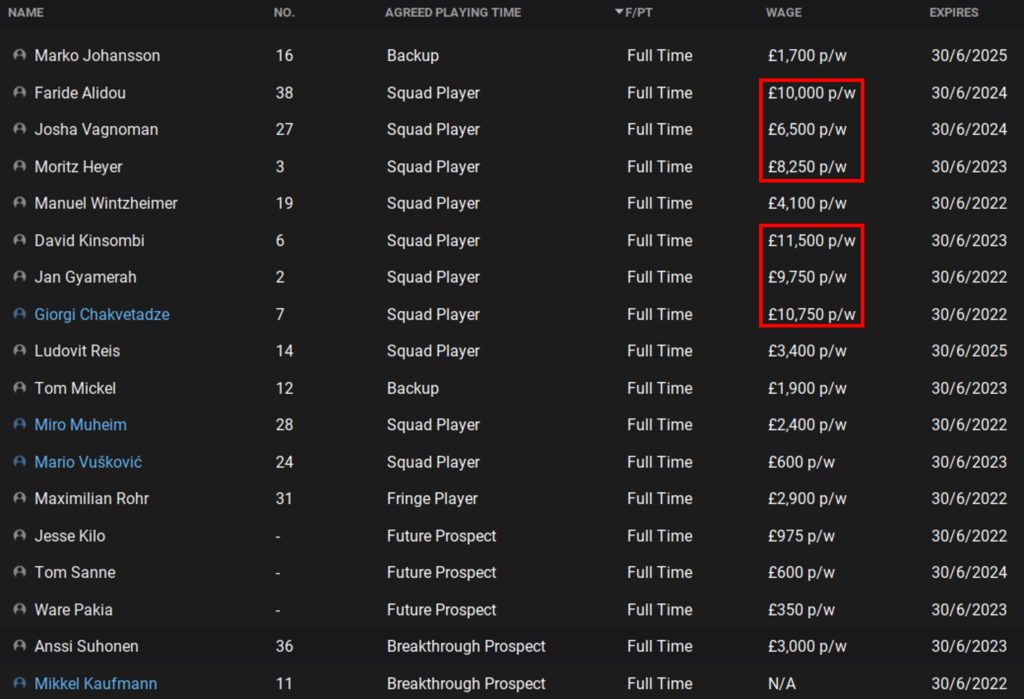
Here is where we are clearly having some issues. Out of our 12 back ups and squad players, half of them are over the £6,150 maximum wage. A combined £17,750 per week over to be exact. These are the (not so) little things which can soon send wage bills spiralling.
I do have to put my hands up for Faride Aliduo, though. I gave him that £10k p/w contract because he’s got 5 star potential and was on an expiring contract. £10k was the minimum he’d sign for and I think he’ll be an important player for the club.
Josha Vagnoman is definitely a Key Player, but I’ll bump him up to the Regular Starter group. It’s OK to have a player in a lower group than he belongs in… but you never want it the other way round.
Motirz Heyer has been a regular starter this season so far but may I reduce his role now that Ambrosius is back from injury, so I’ll leave him as he is and then address him at the end of the season.
David Kinsombi is on much more money than his in-game talent suggests he should be – which is a pity as he’s a player I like in real life due to his energy. He’ll very probably have to leave in this transfer window. Chakvetadze is a loan player who’s spent most of the time getting niggling injuries in training, so I’m considering sending him back to AA Gent as even when fit he’s standing in the way of Anssi Suhonen’s development. Jan Gyamerah is on an expiring contract and wants £14k to renew so he’ll be leaving at the end of the season anyway, unless his demands come down a lot as the season develops.
Youth prospects
As per the breakdown earlier in the post, the youth players should take up the remaining 10% of your wage budget, in my case £20,300.
However – and he’s a major problem I have – there’s currently 90 players on the HSV books, spread across the First Team, B-Team and U19 squads.
Together the B-Team and U19’s are earning a combined £24,900.
There’s no way I need 30+ players in those two squads, especially with a youth intake coming soon. I need to clear out the dead wood. The Director of Football is going to be busy!
So, that’s how to implement a wage structure. Remember though, you still need to have squad harmony and player morale to deal with so if you choose to follow this method, don’t feel a rush to change a player’s status or sell lots of players straight away. My aim would be to tackle the easy wins first, and then aim to start the following season under the wage budget.
It doesn’t just end there though… a wage structure naturally flows into your transfer policy.
TRANSFER POLICY

Meet the Director of Football
Michael Mutzel, at the tender age of 42, has been the Director of Football at Hamburg since 2019. He’ll need that youthful energy as he’s going to be very busy. I intend on leaning on him quite a lot when it comes to our transfer activity.
As well as asking him to recommend signings, I’ll be using the Transfer Target tool to identify and prioritise players I want and leave it to him to go out and negotiate the transfer fee and wages. Obviously, I’ll set upper limits which he’s allowed to offer.
(Note – if you’re more hands on and want tips on negotiating transfers yourself, this excellent article will help.)
Using the Transfer Target method means he’ll first try priority #1, and if he’s unable to agree a fee, or a salary, he’ll move onto #2 in the list, and so on.
Whichever player he signs will be a player I’ve identified and being a positive addition and they’ll be signed within the wage budget.
Here’s how the end-to-end system will work:
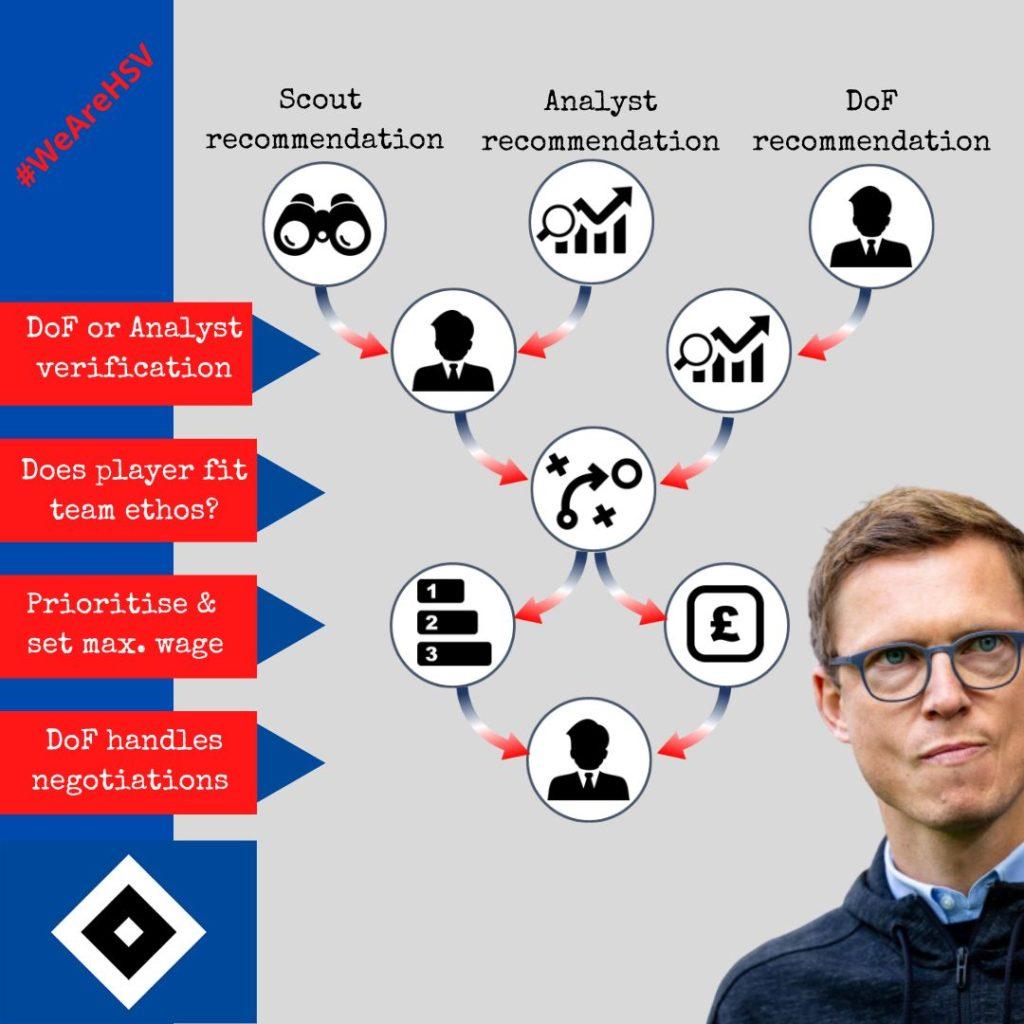
PUTTING IT INTO PRACTICE
It’s all very well have a plan and a pretty chart showing how I WANT it to work, but does it actually work like that in Football Manager?
Let’s find out.
So, despite being £42 million in debt, being over the wage budget and having a starting transfer kitty of £0, the lovely board gave me £2.4 million to play with in the January Transfer Window.
Having carried out my squad analysis going into the winter break, I’ve highlighted that the most pressing need when it comes to strengthening the side is a dynamic midfielder.
More specifically, one who is well balanced in terms of defending and attacking, has the work rate to get up and down the pitch, and has a spark of either creativity or goal scoring. He also needs to be judged already able to play in the Bundesliga.
The Search
In order to find such a player I’m NOT going to use the player search tool. I’m only going to look at players identified by:
- Scouting reports
- Analysis reports
- Director of Football recommendations
because, you know… realism.
For those who haven’t used that last option before, here’s how you do it.
Transfer screen > Director of Football tab > Suggest transfer targets.
In here you can ask your DoF to suggest players from any position you choose and can even specifically ask for: Transfers, Loans, End of Contracts, Free Transfers.

The shortlist
Asking Michael Mutzel for recommendations bought back the following options who might be affordable and would fit within the wage structure:
- Riechedly Bazoer – Vitesse
- Mohamed Ali Ben Rhomdane – ES Tunis
Through looking at the 43 central midfielders who’d been analysed by my Recruitment analysts, I pulled out the following options:
- Ron Schallenberg – Paderborn
- Antione Bernede – RB Salzburg
- Salvatore Esposito – SPAL
And from the scouting reports:
- Jean-Manuel Mbom – Werder Bremen
- Henrik Bjordal – Valerenga
- Boubacar Traore – FC Metz
There’s not too many options due to only being a few months into the game, however, after getting addition verification done by the DoF and Analysts, I was able to narrow those down to the following players who were deemed of already at a Bundesliga standard and are versatile enough to fit into various midfield scenarios.
- Riechedly Bazoer
- Ben Romdhane
- Salvatore Esposito
- Ron Schallenberg
- Jean-Manuel Mbom
Stats-wise all were similar, whilst the transfer-listen Bazoer was the cheapest, but I would be happy with all of them. So I wanted to look at the stats to see if anyone stood out as “the guy”.
Using the numbers
First, after a chat with Matty Lewis (AKA Steinkelsson) whilst we were comparing German saves, I decided to look at “defensive actions” (Tackles/90, headers won/90 and interceptions/90) versus “attacking actions” (assists/90, key passes/90 and chances created/90).
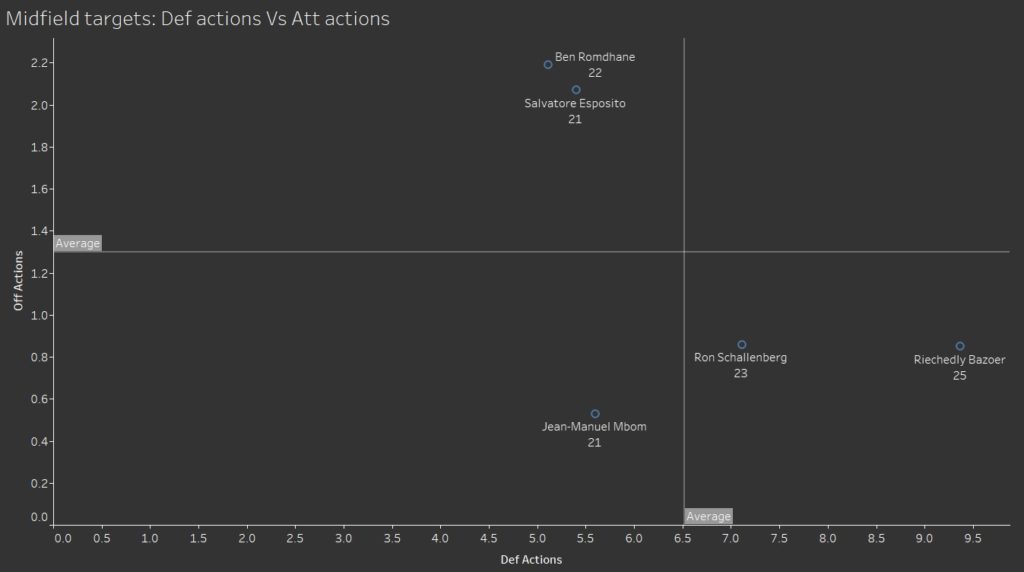
Ideally, I’d want at least one person in that top right quadrant… but they weren’t. So, this visual didn’t help whatsoever…
Back to the drawing board, we came up with ratio of tackles won and ratio of passes completed:

This gave me my guy. My number 1 target. Bazoer, transfer-listed at Vitesse for £1.4 million as he was refusing to sign a new contract, and had a lot of interest from big clubs. I decided against Mbom as Werder Bremem wanted near £6m for him, so Esposito (valued between £2m-£4m) and Mohamed Ali Ben Romdhane (valued between £2m-£6.5m) and fourth, but best attribute-wise) I had Ron Schallenberg. As you can see I put maximum bid amounts in for each player.

After entering the maximum wage allowance, in line with our salary cap, I let our Director of Football go off and do his thing. And here’s how it played out,
- Offer for Bazoer accepted and onto contract negotiations phase.
- Unable to agree a transfer fee for Esposito (we couldn’t afford him)
- Unable to agree a transfer fee for Ben Romdhane (we couldn’t afford him
- Offer for Schallenberg accepted and onto contract negotiations phase.
I knew we had some stiff competition for Bazoer so it came as no surprise to learn he’d come to an end of contract agreement with Celtic.
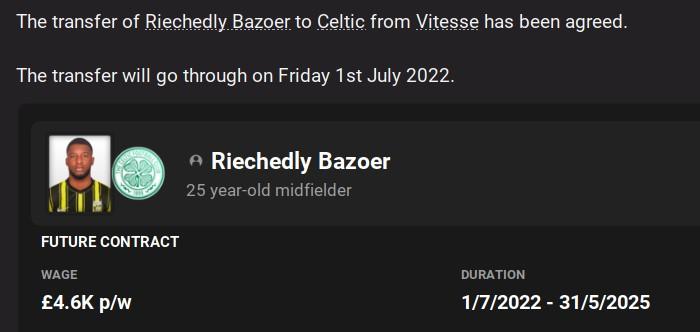
Welcome to Hamburg…
So, it was down to Michael Mutzel to get Schallenberg over the line.

I set a maximum transfer fee of £1.5 million and he’s coming across for £1.3 million, and the maximum wage allowance was £15,400 (our max for a key player) and Mutzel agreed on £10,750.
Welcome to Hamburg, Ron Schallenberg. He’s a good, all-round midfielder who can do a bit of everything. I’d feel comfortable playing him as a deep lying or advanced playmaker, a ball-winning-midfielder, a box to box guy and at a push, even a Mezzala. I think he’ll be a very valuable signing in the seasons to come.
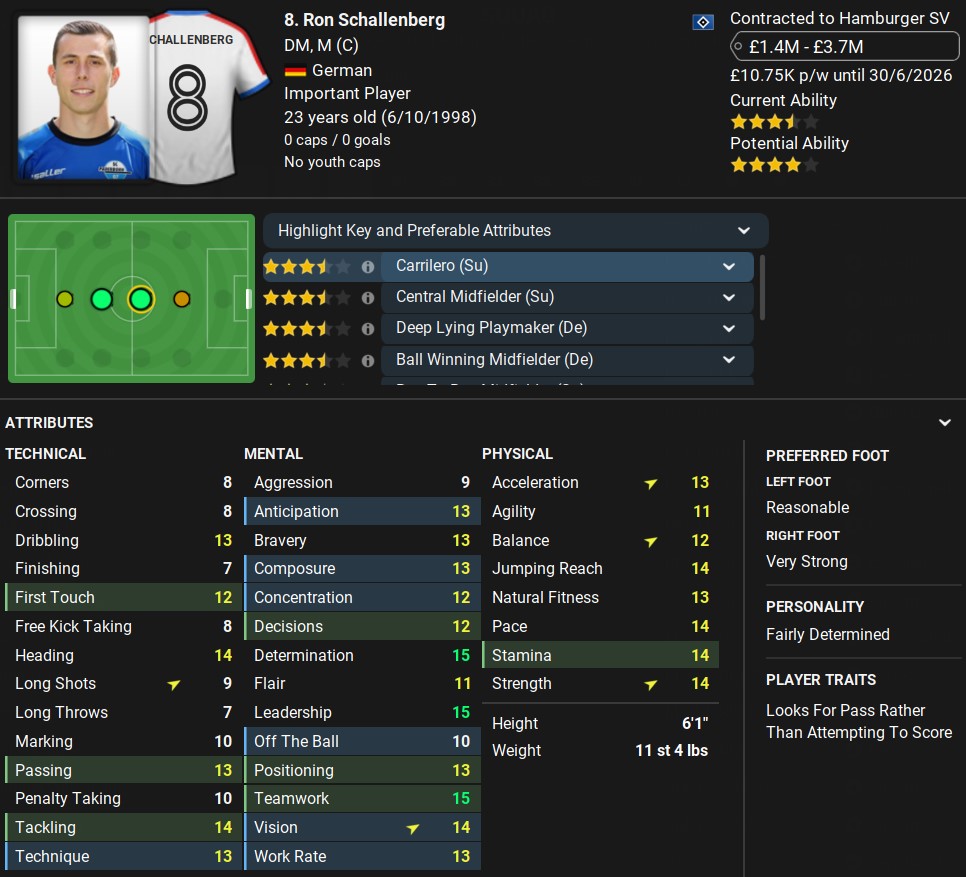
Here’s how he (blue) stacked up against Salvatore Esposito (green):

As you can see, he’s the all round better player attribute-wise so I would’ve been happy with any of them.
So, that’s how I start sorting out club finances by implementing a wage structure and then carry the philosophy on to our transfer policy.
My next update will cover the second half of season 1, including a deep dive into the data and potentially some hardcore soccernomics.
Thanks for reading.
@fm_throwing
4 thoughts on “Implementing a wage structure & transfer policy in Football Manager”
Enjoyed that read very good
Thanks Rob – hope you can put it to good use.
One question I have is that you’ve left the wage offered by the DoF as automatic when adding transfer targets. how do you go about ensuring that they stick to your wage structure which, presumably, is managed outside the game? Im not sure of anyway in game you can set ranges for specific agreed playing time